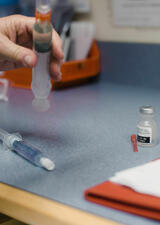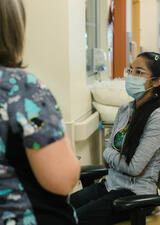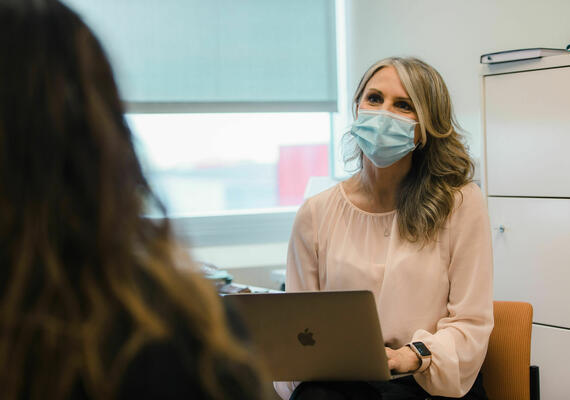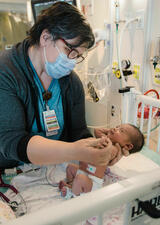How to hold effective vaccine conversations with patients?
Try our Virtual Simulation Games!
Step into CAN-Sim's Vaccine Conversations Virtual Simulation Games (VSG’s), where you can immerse yourself in challenging scenarios to hone your skills in addressing vaccine concerns and fostering informed vaccination decisions. These simulations cover strategies in addressing conversations on vaccine boosters, vaccine hesitancy, vaccine refusal and holding vaccine conversations with specific patient groups. Click below to gain confidence and practice real-life patient interactions.



PrOTCT Framework
When building vaccine confidence with your patients, it can be helpful to utilize a conversation framework to achieve an effective interaction that builds trust while sharing important vaccine information. The PrOTCT framework can help you to have more effective vaccine conversations. To learn more about how to use the PrOTCT framework to support your patient interactions, click here.

Printable Patient Vaccine Action Plan
Support your vaccine advocacy with this printable Vaccine Action Plan template, designed to be used during your appointment to empower your patients to take the next steps with scheduling and receiving their recommended vaccinations.
How can I support my patients with vaccine science?
Explore specific links to resources and dive into comprehensive Q&A answers, equipping you and your patients with the knowledge and tools needed to support your understanding of vaccine science.
Common Questions around Vaccines
Check out some commonly asked questions on vaccine topics.
Basics of Vaccines and Immunization
Infections from many diseases can seriously harm or kill our children before their bodies are able to fight them off. This is where vaccines come into play! The role of a vaccine is to train our child's body to prepare for fighting the disease (make an immune response) without the risk of the actual infection itself. The vaccine is made up of antigens associated with a particular infection. The body builds an immune response creating antibodies. These antibodies are stored in the child's body for future use if the actual disease they were vaccinated against enters their body. Because the immune system has already had practice and is already trained, it will be able to create even more antibodies to fight off the actual disease when it sees it.
It is important for our children to be immunized in order to protect them, and others, from the devastating consequences of many diseases. Many vaccine preventable diseases find the pockets of unimmunized kids and cause severe infections. Some diseases cause worse disease in certain ages groups (for example whooping cough affects babies under 1 more severely, while chicken pox affects kids over 12 more severely).
This is a common concern many parents have. The answer is no, vaccines do not overwhelm the immune system. Our bodies are constantly coming into contact with germs and our immune system is constantly working to protect us from them. Children introduce new germs into their bodies all of the time by eating new foods, playing with other people and pets, touching their mouths or crawling on the ground.
Thankfully, the immune system is smart! It knows to differentiate among the many germs. Getting immunized is a way of training the immune system to react smartly. Vaccines contain antigens (deadened or altered or pieces of viruses or bacteria) of specific diseases that prepare our bodies for when they are up against the real threat (the disease). If we are ever exposed to the actual disease, all of that training kicks our immune system into action to fight the germs quickly and effectively.
Exciting news is that technology has reduced the number of antigens in vaccines today. For example, the diphtheria, tetanus and acellular pertussis (DTaP) vaccine used to have 3017 antigens in 1980, and now has only 34 antigens. Our children's bodies come in contact with many antigens everyday, and have no problem handling the small amount given in vaccines. In fact, vaccines train the immune system and make it even stronger!
We know from extensive research and historical information that vaccination is very effective, however no vaccine is 100% effective all of the time. Most childhood vaccines produce immunity in 90 - 100% of those immunized. For example, after receiving the first dose of the MMR or the measles vaccine, 95% of those who were vaccinated are immune to measles, and after the second dose this number is even higher at over 99%! Individual immune systems are different enough that in some cases, a person's immune system will not generate an adequate immune response. In these rare instances, making sure the rest of the population is immunized is even more important as those individuals whose immune systems do not react to vaccination must rely on herd immunity for protection (community protection).
Safety and Components of Vaccines
Traditional vaccines are currently the most effective tool available to prevent infectious disease. Unlike vaccines which have to undergo rigorous testing and close watch before and after being released to the market, homeopathic and naturopathic vaccines also called nosodes, do not undergo the same rigorous research and surveillance. Health Canada has NOT approved nosodes as "alternatives to vaccines", though many companies market them in this way. This marketing has contributed to a false sense of security for nosode users, and has unfortunately led to the spread of infectious diseases, including measles and pertussis (whooping cough). Health Canada now has regulations that require nosodes to be labeled with: this product is not intended to be an alternative to vaccinations to help Canadians make informed health decisions for themselves and their families. Unlike traditional vaccine companies which have to reveal all components of the vaccines, nosodes are not regulated and often parents have no way of knowing what they have just put into their children's bodies.
To date following a traditional vaccine schedule is the safest, most rigorously tested, and most effective means in which to prevent infectious diseases.
This is an understandable assumption, after all our bodies ward off common illnesses everyday! Unfortunately, many of the diseases that we vaccinate for do not give the body enough time to build up its natural immunity before they cause severe illness or even death. Often when choosing which diseases to vaccine against, scientists choose very deadly and serious diseases.
In some cases, natural immunity is longer-lasting than the immunity gained from vaccination but the risks of natural infection (e.g in meningitis: permanent intellectual disability, deafness and death) significantly outweigh the risks of immunization. The benefits of vaccination outweigh the risks of every recommended vaccine on Alberta's recommended vaccine schedule.
For example, common infections like chicken pox can predispose healthy kids to terrible complications such as pneumonia, encephalitis (inflammation of the brain) and necrotising fasciitis (commonly known as flesh eating disease. However, even uncomplicated cases of chickenpox cause children to miss a week or more of school, with a caregiver missing work to care for the sick child. Having this natural infection means that the child is infectious and can spread the disease to other people, not just other children, but also adults, who have a higher risk of complications from the disease. Successful vaccination protects a child against chickenpox without this risk.
Yes! Vaccines are tested repeatedly before being approved, and continue to be monitored for adverse reactions even after their release for as long as they are on the market. The creation of a new vaccine takes on average, 10 years of research and development to ensure its safety and effectiveness before it is even considered for approval by Health Canada! After a vaccine has been approved for use and made available, its safety is continuously monitored. There are many vaccine safety systems in place in Canada and internationally to monitor and ensure vaccine safety to protect all individuals who are or want to become vaccinated.
The minimal risks involved with vaccination do not compare with the devastating effects of vaccine preventable diseases.
There are many causes of seizures in children including infections, head trauma, lack of oxygen and rarely, vaccination. 50% of seizures children experience are febrile seizures, most often caused by infections. Febrile seizures are relatively common; 2-5% of children will have at least one febrile seizure before the age of 5. This means that between 200 and 500 children out of 10,000 will have a febrile seizure. In comparison, 8 out of 10,000 children will have a febrile seizure after receiving the MMR vaccine. This is much lower than the general risk all children have of experiencing a febrile seizure.
Studies have shown that there is a small increased risk for febrile seizures during the first to second week after vaccination with MMR vaccine and the first dose of the (MMRV) vaccine. This can be treated quickly and easily in most cases. Studies have not shown an increased risk for febrile seizures after the acellular pertussis vaccine, DTaP, or after varicella (chickenpox) vaccine.
Yes! Influenza infection can have serious consequences for pregnant women and their unborn children. Especially women in the third trimester of pregnancy, have a much more severe course of disease with the flu. Influenza immunization is recommended, for your own health and to provide your baby with immunity in the first six months of life when they are most at risk of serious disease (whereas the influenza vaccine gets across the placenta, only the antibodies the mom makes to the vaccine do: not the vaccine components). The National Advisory Committee on Immunization recommends the flu vaccine be given to all pregnant women and there are many studies showing it is safe in all stages of pregnancy.
Some vaccines do contain tiny amounts of egg protein which can cause allergic reactions in some people with egg allergies. These reactions are rare and usually mild, occurring immediately after receipt of a vaccine. Even with severe egg allergies, anaphylaxis caused by vaccination is very rare.
Even though the following vaccines have some trace amounts of egg protein in them, they are still safe to give to people with egg allergies, even people with anaphylaxis to eggs:
- Influenza vaccine (injectable)
- measles-mumps-rubella (MMR) vaccines
- measles-mumps-rubella-varicella (MMRV) vaccine
The vaccine that is absolutely contraindicated currently for people with egg allergies is the Yellow Fever vaccine.
There are a variety of studies that have found no evidence that vaccines cause allergies, but further research needs to be done as some studies have been inconclusive. What we do know is that the benefits of vaccination still greatly outweigh the risks of developing an allergy. Some kids may be allergic to a vaccine or its components.
As a health precaution, all vaccines are given by healthcare professionals in a setting where allergic reactions, though very rare, can be treated quickly and effectively.
Formaldehyde is used early in the manufacturing process of some vaccines to inactivate some viruses or toxins. Every ingredient in a vaccine serves a purpose in making the vaccine safe and effective.
Vaccines contain very little formaldehyde. In fact, at any given time a child's body has contains around 10 times the amount of formaldehyde in found in vaccines. Formaldehyde is produced by the human body in relatively small amounts as part of normal human metabolism, humans may also consume natural formaldehyde in food, in the air we breathe and even in some skin care products. As humans our bodies are able to breakdown formaldehyde rapidly, so there is no build up in the body. Studies have shown no link between formaldehyde in vaccines and diseases.
There has been no evidence linking vaccines to autism. Vaccines are sometimes blamed for conditions that are poorly understood, but independent scientific research has shown there is no link between the measles-mumps-rubella (MMR) vaccine and autism. The initial study that brought this myth forward included 12 patients and it was published in 1998. It has since been retracted from the journal because it gave false, biased information and the main author's medical license has been revoked! In addition, a Danish research team studied 537,303 children that were born between 1991 and 1998. Their study showed that the rates of autism were no different between children that were vaccinated and unvaccinated with the MMR vaccine.
Even in “high risk” kids (those whose siblings have been diagnosed with autism), there was NO increased incidence of autism diagnosis after the MMR vaccine.
So why do some people still assume there is a link between MMR and autism? It is natural for parents to search for a justifiable cause for their child's autism. Often, children get their autism diagnosis in the second year of life (when it becomes clearer that they may not show interest in the world around them and that they have difficulty communicating and interacting). It is at the same time, that the MMR vaccine is being administered. However, just because these two events happen close together does not mean they are connected.
Aluminum salts are added in small amounts to vaccines as adjuvants, which are substances that enhance and strengthen the immune system response. The salts help the vaccines work faster and longer. Adjuvants used today make it possible to reduce the amount of antigens (parts of weak or dead viruses or bacteria) in a vaccine. Aluminum salts and other adjuvants have been proven safe over seven decades of monitoring and testing.
We are regularly exposed to aluminum in our natural environments. Aluminum is the most abundant element in the earth's crust and is found in air, food and water. In the first 6 months of life children, on average, are exposed to 10 mg of aluminum in breast milk as opposed to about 4 mg in vaccines.
Yes, research has proven that thimerosal in vaccines is safe. Thimerosal is a mercury-based preservative that has been safely used in some vaccines since the 1930s. Studies suggest that thimerosal to preserve vaccines pose no threat to vaccinated individuals, but can be associated with mild reactions at the injection site reactions such as redness and swelling.
However, due to all the attention thimerosal has had in the media, it has now been removed from of most of the childhood vaccines. No vaccine made in Canada since March 2001 for routine use in children contains thimerosal, with the exception of a special type of influenza vaccines. DTaP, Polio and Hib vaccines have not contained this preservative since 1997-98 and the MMR vaccine used in Canada has never contained thimerosal.
No, vaccines do not contain cells from aborted fetuses and do not contain human cells or tissue. In the production of some vaccines, human cells are used in the early stages as viruses require a living cell to grow. In the purification process of the vaccine, all cells are removed. The rubella vaccine is cultured from human cells and some came from legal abortions done in the 1960s and continue today from the original source. None of the abortions were conducted for the sole purpose of vaccine production. New fetal tissue is not needed for the ongoing production of vaccines because cells are able to be reproduced in the lab, and thus can be repeatedly used for a very long time.
Vaccine Effectiveness and Disease Eradication
Vaccines can be made with dead germs (viruses or bacteria ), or only part of a germ, or with live, weakened germs. It is impossible for vaccines that are made with the cells of dead viruses or bacteria or only part of the virus or bacteria to cause illness.
Live, weakened vaccines are created to be very safe. In theory, it is possible for an immunized individual to become ill with the disease after vaccination with a live vaccine. However, the scientists who create these vaccines understand this possibility and formulate live vaccinations to reduce the possibility of illness as much as possible while still maintaining the effectiveness of the live vaccine.
Though live vaccines (on the Canadian schedule only the MMR, Varicella and Rotavirus are live vaccines) are perfectly safe for most Canadians, it is important to know that this type of vaccine can cause serious complications for people with weak immune systems (like patients who have an organ transplant or pregnant women). Doctors and nurses caring for those people may choose to give them a non-live vaccine, if one is available, or that person may have to depend on the immunity of people around them to protect them from the illness (herd immunity), which is another reason why getting vaccinated is so important.
It is important to understand the true meaning of the word 'eradication': Eradication, means that the disease is no longer affecting anyone, anywhere. In the current vaccine schedule there is no vaccine that protects against any eradicated illness. Other diseases that are reducing in numbers are doing so because of the success of vaccinations. If people stop vaccinating, these diseases will re-emerge and outbreaks will occur. As we have seen with measles and whooping cough outbreaks in Alberta, often these diseases are just a plane ride away.
This is an understandable assumption, after all our bodies ward off common illnesses everyday! Unfortunately, many of the diseases that we vaccinate for do not give the body enough time to build up its natural immunity before they cause severe illness or even death. Often when choosing which diseases to vaccine against, scientists choose very deadly and serious diseases.
In some cases, natural immunity is longer-lasting than the immunity gained from vaccination but the risks of natural infection (including permanent disability and death) significantly outweigh the risks of immunization. The benefits of vaccination outweigh the risks of every recommended vaccine on Alberta's recommended vaccine schedule.
For example, common infections like chicken pox can predispose healthy kids to terrible complications such as pneumonia, encephalitis (inflammation of the brain) and ecrotising fasciitis (commonly known as flesh eating disease. However, even uncomplicated cases of chickenpox cause children to miss a week or more of school, with a caregiver missing work to care for the sick child. Having this natural infection means that the child is infectious and can spread the disease to other people and not just other children, but also adults, who have a higher risk of complications from the disease. Successful vaccination protects a child against chickenpox without this risk.
Yes, it is one of the two cancer preventing vaccines we have on the schedule! It targets HPV strains that cause most cervical cancers as well as anal, penile, vaginal, vulvar cancers as well as cancers of the head and neck. It also protects against genital warts which have become very common. Three out of four sexually active people will become infected with HPV at some point in their lives. While most of these infections will go away on their own, some will not, and the HPV vaccine protects against the most dangerous strains.
You may be asking yourself, why do I want to immunize my child for HPV if they aren’t even sexually active yet? Statistics show that most youths who become infected with HPV first catch it within 2 to 5 years of becoming sexually active. That is why it is so it is important to vaccinate before sexual activity begins. Similarly, younger teens have a more robust response to the vaccine in terms of antibody levels and need only two doses (vs older teens and adults who need 3 doses of the vaccine).
Practical Considerations and Concerns
Injection can be a scary thought and experience for children and adults, and as administrators we want to reduce pain as much as possible. Unfortunately however, shots are almost always the most effective method to administer most vaccines. Luckily, the mild and short-term pain at the injection site of a shot is minimal compared to the painful, or even deadly effects of some vaccine preventable disease!
That said, research is always being performed to find alternatives to shots. For example, the annual influenza vaccine may be administered as a nasal spray as the FluMist for kids between ages of 2 and 17 years and Rotavirus vaccine can be given as an oral solution.
There are some simple steps to take to improve your child's comfort during vaccination. Think Distract, Position, and Feed! With distraction, and proper positioning with parental support, vaccines can be administered quickly with minimal discomfort. Timely breast feeding, and topical analgesics can help too! Your healthcare provider will give you advice on how you can help to make your child as comfortable as possible during vaccination
For older children, it can also be helpful to talk to them about vaccination and how vaccines work to protect them from diseases (like little superheroes!) and have them engaged in a vaccination plan with possible visualisation (the where, how, when of the actual vaccine administration). Using distraction (screen time, virtual reality) and incentives can help as well for those with needle fears.
Vaccines are given in infancy because infancy is the time in a child's life when they are particularly susceptible to dangerous and potentially fatal diseases. Children are exposed daily to a multitude of antigens and yet their immune system knows to differentiate among them all. Similarly with vaccines, the immune system recognises them as trainers and responds accordingly.
Of course, no one wants to see their child experience pain. It is important to remember that the pain from a vaccine is more surprising, generally very minimal, and over within seconds. Several studies have determined that simultaneous vaccination with multiple vaccines have no adverse effect on a normal child's immune system or overall well being. Moreover, multiple immunizations in one injection means that children have fewer injections, fewer office visits and less discomfort. Spreading out vaccines may increase pain and leave children unnecessarily vulnerable to disease.
Some vaccinations are able to offer lifelong immunity with only one dose, while others need multiple doses to provide full immunity or boosters to maintain immunity later in life.
For vaccines requiring multiple doses, the first dose of the vaccine only provides a low level of protection, immunity is increased with multiple doses of the vaccine. If a disease progresses quickly through an individual, a booster shot is an effective way to remind the body how to respond to that specific disease so that the body is prepared to fight it.
One exception is in the case of the flu vaccine, the flu strain that is being protected against is the strain forecasted by infectious disease experts to be prevalent that year. As the strain changes from year to year, so does the vaccine, which is why we need annual doses of the influenza vaccine.
Many diseases prevented with the vaccinations that are recommended by Alberta's vaccine schedule can occur in very young infants that, without vaccination may not otherwise be capable of protecting themselves. For example, in pertussis, or whooping most severe cases and deaths occur in young infants (younger than 6 months of age; the younger the baby the higher the risk). We vaccinate against pertussis at 2,4,6 months. After just one dose of the vaccine however, babies are not fully protected, but by the third dose, they have finally build a robust response. In addition, if the mom herself is immune, she can pass antibodies to the baby through the placenta in the third trimester of pregnancy (which is why we recommend that all pregnant people, with each pregnancy, have a pertussis containing vaccine in 3rd trimester to protect the baby as soon as birth).
Antibodies can also pass through breast milk. This passing of antibodies is called passive immunity. However, passive immunity only lasts about 6 months, just in time for the baby to start relying on their own immune response to the vaccine! Fortunately, however, most babies are born with an immune system capable of creating a good immune response to vaccination which protects them from many of these illnesses while boosting their immune systems and immune responses to disease.
The Alberta Health Vaccine schedule has been thoroughly studied and found to be the most safe, effective process to vaccinate our population. The suggested vaccine schedule was created to minimize risk associated with infectious disease and targets children and infants when they are at the highest risk of infection and any prolongation of the vaccine schedule can significantly increase the risk of disease. Alternative vaccine schedules can put infants, children and adults at unnecessary risk of disease and failing to immunize on time can also affect "herd immunity" by putting immune compromised members of the community at risk of potentially fatal infection.
Mothers can pass on protection from diseases to her baby during pregnancy and while breast feeding. The baby receives protection from diseases that their mothers have had in the past or against those which she has been vaccinated for in the past. This protection is short term only lasting 6-12 months after birth (if not breast feeding) or shortly after their mother discontinues breastfeeding.
Also, protection against certain infectious diseases, are not transferable because of low numbers of antibodies being passed to the child. This means the baby cannot depend on breast feeding to provide protection against them. Premature babies are especially vulnerable to vaccine preventable diseases because their immune systems are not well developed and they are less likely to benefit from protection from breast milk.
The protection gained from breast feeding compliments the benefits of vaccinations, so both is best!
Pneumococcus
Severe disease in the form of meningitis, pneumonia, blood and bone infection. It is the most common form of meningitis and 1 in 3 children who survive, have long-term sequelae such as intellectual disability or deafness. Even though we have antibiotics we can use against this disease, we still have 1-2 deaths every year in Alberta from this pathogen. The pneumococcal vaccine is none live vaccine which is safe and well-tolerated and offered at 2 4 and 12 months.
Measles
Prior to the pandemic, high numbers in European countries such as Italy and Eastern Europe as well as the US. Now, as of 2023-2024, we are seeing a resurgence of measles with cases in Canada.
Once the case numbers reach 3-400, we start seeing very severe disease and death. Kids are more affected by this virus, which causes high fevers, rash, conjunctivitis but also lung infections and brain infections (encephalitis).
To be considered fully protected, kids need two doses of an MMR vaccine (no measles only products are available in Canada).
Pertussis (Whooping Cough)
This bacterium causes lung infections in the community outbreaks causes prolonged pneumonia and is known to 100-day cough. In babies, there was under 1 year of age, despite antibiotics, whooping cough causes such severe inflammation that we do not have effective treatments for it. We have tried ventilators, full blood replacement transfusions, anti-inflammatory medications and we still grapple with deaths and severe complications in our youngest patients.
Since people are contagious for weeks after the start of whooping cough, this is easily spread in the communities: which is why we still see regular pertussis outbreaks. Once it finds that unimmunized young baby, pertussis leads to prolonged and complicated hospitalisations and deaths.
The non-live vaccine against pertussis comes in one injection as combination with tetanus, diphtheria and polio (and some other studied and safe combinations exist with hemophilus B and Hepatitis B vaccines). Babies need 3+ doses to be fully protected. We have also found that the most effective way to protect babies before they can get their vaccine (2 months), is to vaccinate the pregnant mom in third trimester.
Influenza
This virus comes without fail every winter season. It is enough on its own to make kids very sick with body aches, fevers, headaches and viral pneumonia. However, it also predisposes kids to secondary bacterial infections such as Group A strep and pneumococcus and together with these, can lead to brain, lung and blood infection. Those kids under 5 seem to be more likely to end up in hospitals, even though in the last 2 seasons (2022-2023), we have also seen older previously healthy kids get very sick.
A non-live vaccine given every year is around 50-60% effective at keeping kids out of hospital and needing medical attention for the flu.
Information on vaccine specific topics
Explore this section to access expert insights, guides, and scientific findings, empowering you to make well-informed choices about vaccination for yourself and your patients.
- Vaccine Schedules
- Immunization Guides
- Disease specific information
- Vaccine and Vaccine Preventable Diseases
- Vaccine Ingredients
- Benefits & Safety
- Biological Product Information
- PHAC Recommended Immunization Schedules
- Reporting Adverse Events

How can I measure the impact of my vaccine conversations?
Check out the framework below for an objective patient-centered tool to assess the effectiveness of your vaccine conversations with patients.




